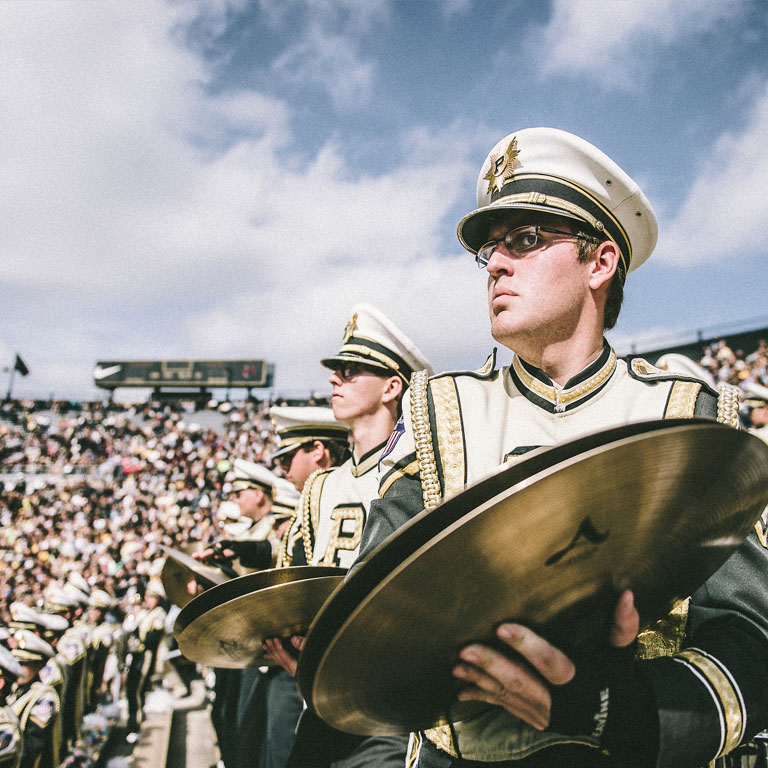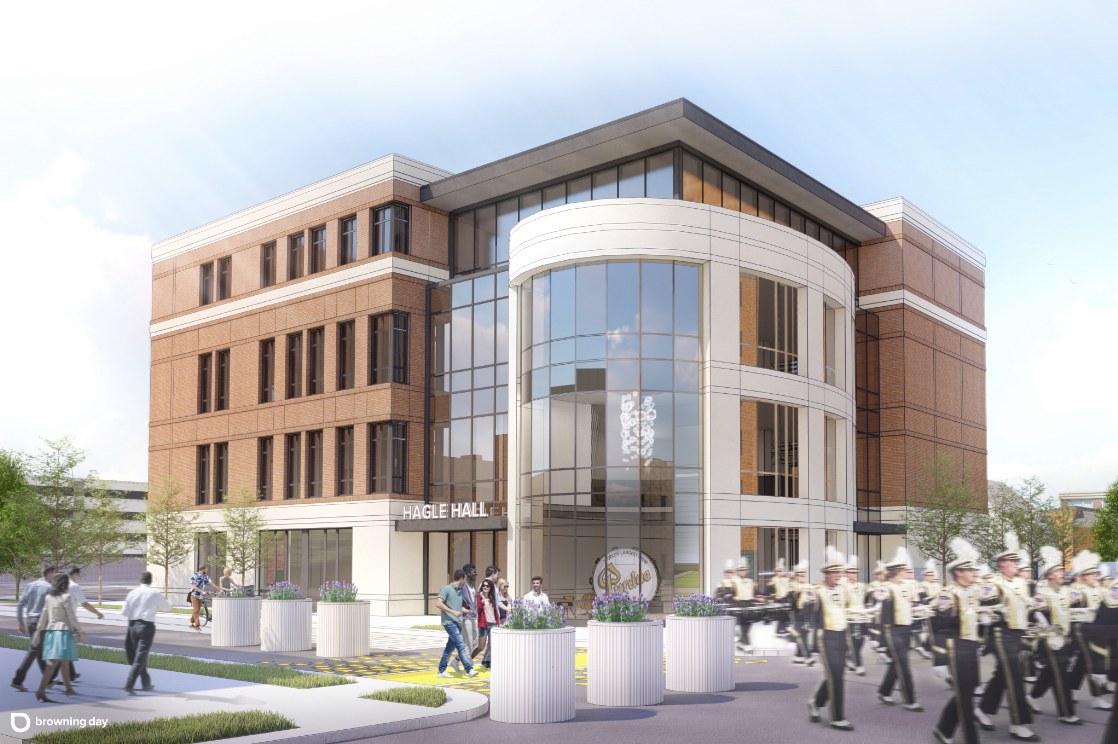Building to a Crescendo: Purdue’s New Bands and Orchestras Building

After 75 years of practicing in the basement of Elliott Hall of Music and scattered spaces across campus, Purdue Bands & Orchestras is building a new home thanks to a generous leadership gift given by Marc and Sharon Hagle. The 37,500-square foot Marc and Sharon Hagle Hall will be located at Third and Russell Streets along the heart of the student corridor. Additional donations are needed to see the $20 million building to fruition. Construction is expected to start in September 2020 and finish by spring 2022.
Marc Hagle began playing percussion in the Purdue “All-American” Marching Band and Symphony Band in 1966 when Al Wright was the director. The following year, Hagle marched in the Rose Bowl where Purdue played the University of Southern California. Hagle holds a bachelor’s degree in electrical engineering, a master’s in industrial administration and a warm place in his heart for Purdue Bands & Orchestras. Hagle is CEO of Tricor International, a real estate development company headquartered in Winter Park, Florida.
In 1949 when there were 150 members in the band, Elliott Hall of Music was an adequate rehearsal space, but as the band program grew—with more than 1,200 students participating in 30 ensembles today—it became cramped and inefficient.
Jay S. Gephart, the Al G. Wright Chair of Purdue Bands & Orchestras, is looking forward to the new building that will raise the bar for students, faculty, alums and the University as a whole. “The new building will be a real game changer for our department,” Gephart said. “Our facility has been adequate for the last 75 years, but times have changed so much. Technology has changed and our department has grown significantly.”
Hagle sees Purdue Bands & Orchestras as not only enhancing the college experience for students but also enriching overall University life.
“The band was one of the reasons that I went to Purdue,” Hagle said. “My desires were to receive an excellent education and also be involved with a stellar band program. The Purdue band was stellar then and is stellar today.”
The new building will have state-of-the art acoustics, ample storage and space to welcome the Purdue Jazz Bands under the same roof. For the past 15 years the Jazz Bands have been rehearsing at Slayter Center for the Performing Arts.
“The new facility will provide rooms for individual and small group practice, which is something that we do not have in the Hall of Music,” Gephart said. “It’s something that is desperately needed. Our students want to practice outside of their rehearsal times, but they just don’t have locations to do it.”
Something as simple as an elevator is a major turning point. For the first time in 75 years, large equipment will not have to be manually moved up stairs to leave the building for performances. “Right now, the only elevator we have is the orchestra lift in the Hall of Music,” Gephart said. “And the only time we can use that is when it’s available to us. During November and December, once the PMO Christmas Show has moved in, our students have to carry timpani, marimba, xylophones, chimes and all the large percussion equipment up a flight of stairs to move it out of the building for concerts. In fact, it is really quite dangerous to move these instruments.”
When not in use, the Big Bass Drum will have its own prominent place in a display window in Marc and Sharon Hagle Hall that can be seen from the outside. “Folks will be able to walk by the building and have their picture taken in front of the drum,” Gephart said.
The Third and Russell Streets building will be the main site. A secondary site will be created as an addition to the existing Turf Recreational Exercise Center (TREC) north of Hull Field where the marching band practices. The addition will feature changing facilities as well as instrument and uniform storage, making it possible for the band to practice on Hull Field without spending the 26 minutes each day marching there from Elliott Hall of Music and back, as is the current practice. “We use that time to rehearse, but that is a lot of rehearsal time that could be spent at Hull Field preparing for performances,” Gephart said.
While seeing and hearing the band march across campus each day in the fall is a magnificent sight and sound, it has drawbacks. “I talked to Al Wright about that and he said it became a tradition out of necessity,” Gephart said, “When he was the director (from 1954-1981), he did exactly the same thing we do today. And it was just an organized way for the students to get to the drill field and back. It was never intended to be a daily parade rehearsal.”
When the weather is bad, the new TREC space will provide much-needed indoor practice area on a turf field. “Now when there is inclement weather, the students go into the Hall of Music and stand out in the seats,” Gephart said. “We rehearse on the edge of the stage. It’s not the greatest.”
Membership in the band program grew 65 percent between 2013 and 2018. The department is a draw for students because of the quality Purdue offers. “We have an incredible faculty here and it’s very attractive to our students,” said Gephart. “We also talk about the concept of the Purdue Band family. Students feel like they are part of something special when they come to Purdue and become involved in the band and orchestra department.”
About 70 percent of students in Purdue Bands & Orchestras are in STEM disciplines, with 40 percent of those students in engineering. While some may see music as an added extra to the STEM focus, Gephart sees it differently.
“I believe that music and the arts have to be treated as something significant, standing alone,” Gephart said. “We can’t view the arts as something that just props up STEM. For Purdue to be a world-class University, it has to be more than just a STEM-centric place. It has to provide students with an outlook that they seek and often that outlook happens to be in the arts.”
Follow Purdue Bands & Orchestras on Instagram ![]()
@purduebands
 .
.